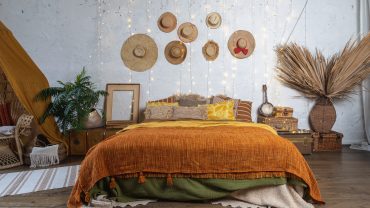Known for their distinctive blend of elegance, whimsy, and intimacy, rococo interiors first emerged in early 18th century France. Just like baroque interior design before it, rococo involved elaborate ornamentation. But it was also a stark departure from the drama and illusion of its predecessor. Some even say it was a reaction to it. One thing’s for sure: the two are intrinsically linked. In fact, rococo interior design is sometimes known as late baroque.
So, what was behind the change in trends? And precisely what is rococo interior design? Let’s start at the very beginning.
History of Rococo Interior Design

King Louis XIV visits the Académie Des Sciences in Paris, 1667 (Credit: Roger Viollet via Getty Images)
The rococo style emerged following the death of King Louis XIV in 1715. With his successor too young to rule, France went through a regency period under the Duc d’Orleans. It was the regent who, favouring city life over that in the countryside, decided to move the royal court from Versailles to Paris. As members of the aristocracy moved from living in spacious country homes to intimate city apartments, they no longer had the space required for the grandeur and scale of the baroque style. This was one of the main factors in the shift in trends. Suddenly, the homes of the elite became personal and intimate spaces.
At the same time, there were changes in both the social and cultural inclinations of the aristocracy. Rococo interiors embodied this shift through their decorative art and design. Unlike the imposing baroque that preceded it, rococo was about creating a sense of informal elegance and comfort, spreading rapidly across Europe and being adapted to suit the tastes and sensibilities of various countries.
What is Rococo Interior Design?

Gold four poster bed in elaborate Rococo bedroom. (Credit: Scott Van Dyke via Getty Images)
So, what made up the style that would come to be known as rococo?
Ornamentation
The rococo interior design style is renowned for its elaborate ornamentation, featuring intricate curves and counter-curves, often described as ‘rocaille’, which mimic the natural forms of shells and waves.
Pastel Shades
This style embraces a palette of soft pastel colours, contributing to the airy and whimsical atmosphere of rococo interiors.
Sumptuous Comfort
Furniture in the rococo interior style was designed with an emphasis on comfort, functionality, and beauty, showcasing ornate carvings and a preference for fluid, naturalistic lines.
Luxurious Materials and Textures
Silk, gold leaf, and marble are just some of the opulent materials with prominent roles in rococo design.
Light and Elegant
Lighting fixtures and art, including mirrors, crystal chandeliers, and frescoes, enhance the elegance and ethereal quality of rococo interiors, often depicting themes of love, nature, and classical mythology.
Rococo Versus Baroque: Understanding the Differences

Luxury white and blue interior living room with Rococo walls (Credit: Yaroslav Litun via Getty Images)
Both baroque and rococo interior styles share a love for detailed ornamentation, the incorporation of natural themes and of soft lines and curves, but they diverge significantly in other ways, such as:.
A Lighter Touch
In contrast to baroque’s grand scale and dramatic contrasts, rococo leans towards a lighter, more playful approach, focusing on leisure and pleasure. Even in terms of colour, baroque’s intense, rich shades gave way to rococo’s pastels.
Scale and Ornamentation
Rococo interiors are characterised by a smaller scale and more delicate ornamentation compared to the grand and dramatic baroque style.
Skewed Approach
Whereas baroque was all about symmetry, the rococo interior style favoured an asymmetrical approach.
Incorporating Rococo Design in Modern Interiors

Pillows lay on antique, luxury furniture incorporating a rococo interior style. (Credit: ponsulak via Getty Images)
Adapting the rococo aesthetic to modern interiors involves selecting elements that embody the style’s elegance and lightness without overwhelming contemporary sensibilities.
Modern rococo interiors might include furniture with gentle curves and ornate detailing, perhaps in muted colours or with a touch of gold leaf to echo the luxuriousness of the period. Incorporating wallpapers or fabrics with delicate floral patterns, pastoral scenes, or classical motifs can also bring a touch of rococo flair to a room.
Choosing colour schemes that reflect Rococo’s preference for pastels – soft pinks, blues, and greens – can help create a serene and inviting space. When it comes to materials, incorporating velvet, silk, or replicas of period-appropriate textures can add a sense of luxury and comfort reminiscent of rococo interiors.
Balancing old and new is key to integrating rococo elements into modern designs. A Rococo-style ornate mirror or chandelier can serve as a focal point in an otherwise minimalist room, offering a nod to the past while maintaining a contemporary feel.
Summarising the Rococo Interior Design Style

Palace of Fontainebleau, Ile-de-France (Credit: G. Dagli Orti / De Agostini Picture Library via Getty Images)
And so, the rococo interior design style is all about ornamentation, lightness, and a playful engagement with themes of nature and love. It offers a fascinating glimpse into the artistic and cultural sensibilities of 18th-century France, but maintains a timeless appeal.












